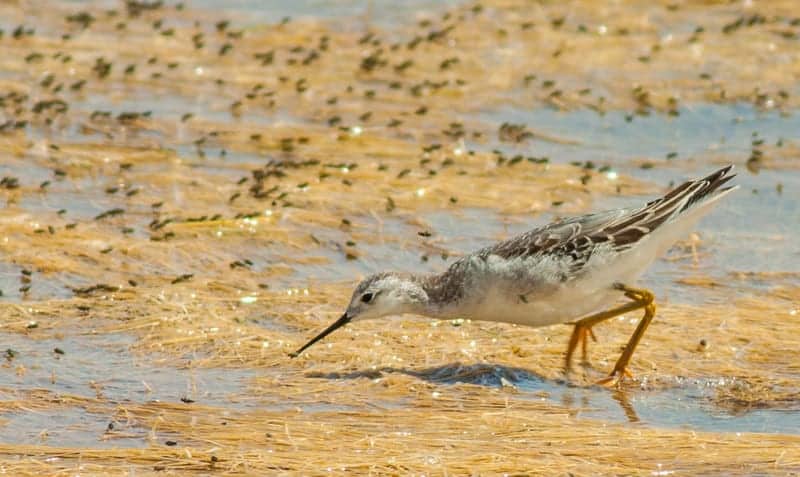It used to be that when I went to Merritt Island NWR, my sole destination was Blackpoint Wildlife Dr. It is by far the most popular part of the refuge, especially for visitors from out of town. But the refuge actually has many wonderful locations.
Some are wildlife drives, and some allow you to get out of your car and walk a bit.
I thought it would be good to offer a brief summary of the best locations on the refuge.
You can consult my field reports as well.

Those that visit the refuge frequently know every nook and cranny of it, but there are about 9 locations on the refuge that are relatively easy to find with excellent birding opportunities. The above map is turned sidewise–north is to the left. But you can see I-95 and the Max Brewer bridge over the inter-coastal waterway on SR-406 that takes you on to the refuge.
-
Pumphouse Loop
— Shortly after crossing the Max Brewer Bridge to put you onto the Island, you’ll see a road to your left called Pumphouse Loop. You can turn on that road and park, then walk the trails. I commonly see Reddish Egrets, Roseate Spoonbills, and during the right time of year this can be a place to find lots of shorebirds. This is the area where the Curlew Sandpiper was seen in May 2015.
-
Blackpoint Dr
— From Pumphouse Loop it’s a short drive to Blackpoint Dr. There are two parking areas on the drive. I usually stop and get out of my car at each, and the second parking area has restrooms. Some of the trails there will take you right into saltmarsh mosquito territory, and they are are viscous. The drive will let you see many gulls, terns, wading birds, and to some extent even shorebirds. There is a pay station at the beginning of the drive.
-
Scrub Ridge Trail
— If take SR-406 all the way to SR-3 and make a left, you’ll see the Scrub Ridge Trail on the right. This is a very good place to see Florida Scrub Jays. Bring bug spray, and take it with you on the trail. No joke, the mosquitoes here can be fierce.
-
Biolab Rd
–Just past the Scrub Ridge Trail, Biolab Rd will take you south toward Max Brewer Memorial Parkway (the access road for the Canaveral National Seashore). This is the best shorebird location on the island, in my opinion. If you enter from the south, you’ll have somewhat better views, since you’d be heading north, but then you have to pay at the entrance to Canaveral National Seashore.
-
Peacock’s Pocket
— This road is longer than Blackpoint, and it goes predominantly east-west, so in the morning, I start on the eastern entrance (where the link to Google Maps takes you). That way the sun will be behind you more of the time. This is a relatively long drive, so give yourself lots of time to drive it slowly and get the most out of it.
-
Visitor Center
— It’s a great place to visit. During migration you can see warblers and other migrants.
-
Oak Hammock
— Oak Hammock is very near the Visitor’s Center on the other side of SR-402. This is the best place to find warblers, thrushes and other migrants. Again, this is a good place to get eaten by mosquitoes.
-
Shiloh Marsh
— Shiloh Marsh is near the northern edge of the refuge; it’s so north it’s in Volusia County. I normally go here in the fall and winter to see sharp-tailed sparrows. A few years ago, a Scissor-tailed Flycatcher spent the winter here.
-
Canaveral National Seashore
— Other than the fact that you have to pay to get in, this is a beautiful beach. It is technically a national park, not part of the refuge, but they border each other, so I’m including them here. It’s a great place for shorebirds, gulls, terns, and pelicans.

So far I’ve seen 188 species of birds at MINWR and CNS. During certain times of the year it can become somewhat crowded with fisherman, duck hunters and other birders, but the refuge is easily the best birding I have available to me within a couple hours of my home. It’s highly recommended.








Scott Simmons
Scott Simmons, based in Florida, is a lover of nature, landscape, and wildlife photography. Scott became interested in photography in 2001 when he was given his first SLR camera. When he acquired a telephoto lens, he became progressively more interested in birds and other wildlife. Scott enjoys learning about bird habitats and behavior, striving always to take images that are both beautiful and interpretive. Scott believes photography is a great vehicle to help others to appreciate the wonder for the stuff of earth.
Leave a Reply